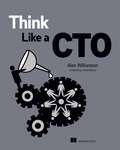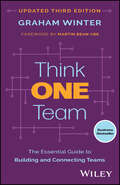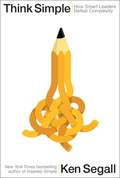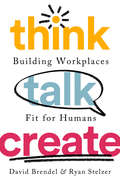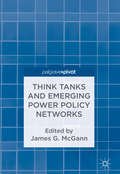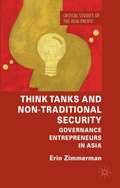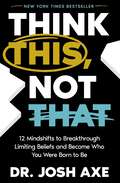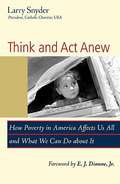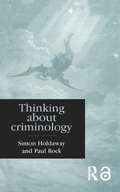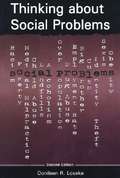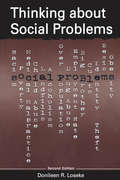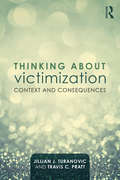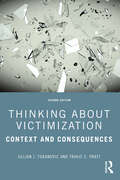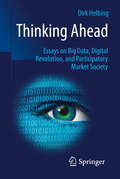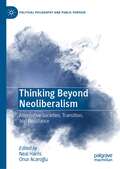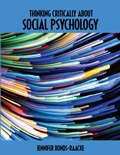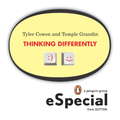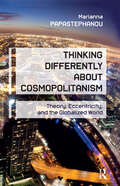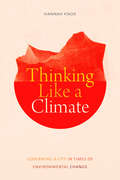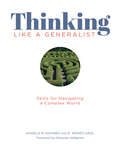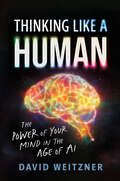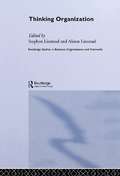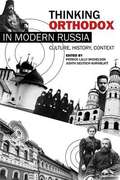- Table View
- List View
Think Like a CTO
by Alan WilliamsonAn effective Chief Technology Officer shapes almost every aspect of a modern business. This book shares the experience and advice of veteran CTOs and industry experts for handling IT crises, leading tech teams, and creating an inspiring vision for your company.In Think Like a CTO you will learn: Effective interaction and relationship-building with other C-level executives Creating long term visions and executing on short term goals Interviewing, hiring, and terminating team members Negotiating salaries and managing promotions Architecting future-proofed systems Handling security breaches and ransomware attacks Putting together budgets and working with your CFO Identifying and managing outsourced vendor opportunities Managing and communicating bad news by leading with data, not passion Being the kind of leader that employees want to follow and emulate Becoming a CTO is an incredible accomplishment. It&’s also one of the hardest transitions a technologist can make. This high-power and high-pressure role demands skills that are rarely developed as a software engineer. Think Like a CTO shines a light on all the areas an aspiring CTO needs to master to succeed. You&’ll learn how to build incredible working relationships with the rest of the C-suite, transform a company with private equity, and recruit and manage your development team. With this book as your guide, you&’ll quickly become a trusted leader figure with an inspiring vision for your company. Foreword by Ankit Mathur. About the technology The Chief Technology Officer balances business needs with the constantly evolving world of technology. Think Like a CTO helps you develop the skills and mindset you need to take on this critical role and emerge as a successful leader. Packed with insights from industry experts and veteran CTOs, this book shares practical strategies for navigating the high-stakes world of technology leadership. About the book Think Like a CTO shares hard-won lessons on how to thrive in the fast-paced role of Chief Technology Officer. Inside, you&’ll learn to establish successful technology platforms and teams, with practical frameworks for software selection and implementation, bias-free interviews and performance reviews, and earning your place at the table with other senior leaders. You&’ll appreciate the no-nonsense advice, insights, and war stories from CTO mentor Alan Williamson. What's inside Building productive relationships with other C-level executives Negotiating salaries and managing promotions Architecting future-proof systems Handling security breaches and ransomware attacks About the reader For technology leaders working in or aspiring towards a CTO role. About the author Alan Williamson has advised numerous CTOs who were catapulted into the big leagues by private equity investment, acquisition, and rapid growth. Table of Contents 1 The Chief Technology Officer (CTO) 2 Managing up 3 Visionary planning 4 Building a team 5 Interviewing, choosing, and onboarding 6 Team management 7 Annual reviews 8 Technology decisions 9 Development 10 Contract management 11 Documentation 12 Security 13 Housekeeping 14 Company growth 15 You, Inc.
Think One Team: The Essential Guide to Building and Connecting Teams
by Graham WinterUnlock your team’s potential The era of disconnected teams and silo thinking is over. When leaders and teams are not aligned and don’t collaborate effectively, they put the whole organisation at risk. A disjointed organisation frustrates employees, irritates customers and causes countless opportunities to be lost. Think One Team: The Essential Guide to Building and Connecting Teams weaves an engaging narrative that reveals how to free your team and organisation of disunity. Inside this innovative bestseller, you’ll discover how to establish and nurture the mindset and habits of united leadership, cohesive teamwork and a one-team culture. With Think One Team, you will learn a powerful model for five practices that will transform fragmented groups into unified teams. Along the way, you’ll gain vital skills, tools and methods for being a strong team contributor. A revolutionary 90-day plan will guide you in empowering your team and organisation to truly thrive in a rapidly changing world. Discover how to: Replace obsolete silo-based thinking habits with a mindset that embraces and harnesses diversity in all its dimensions Collaborate and co-create to enable agility and adaptability Shape a culture where people achieve more together Lead, build and connect high-performing teams It’s time to unlock the potential in your team and organisation. Through the entertaining story of the Big Jelly Bean Team – and an easy-to-implement model – you’ll learn how to break the cycle of silo-based thinking and empower your team to act as a focused unit. Think One Team is an indispensable resource for creating and sustaining an agile, collaborative culture.
Think Simple: How Smart Leaders Defeat Complexity
by Ken SegallSimplicity is arguably the most potent weapon in business—attracting customers, motivating employees, helping outthink competitors, and creating new efficiencies. Yet rarely is it as simple as it looks. Ken Segall’s first book, Insanely Simple, was based on observations gained from twelve years working as Steve Jobs’s advertising agency creative director, first with NeXT and then with Apple. He saw firsthand that Jobs looked at everything through the lens of simplicity. His obsession with simplicity was not just visible in Apple’s products. You could see it in the way the company organized, innovated, advertised, sold at retail, and provided customer service. In practice, simplicity was Jobs’s most powerful business weapon. It helped Apple distinguish its products and create entirely new product categories, and it put distance between Apple and its competitors. But, while Apple is a terrific example of a company that has been propelled by the power of simplicity, it is hardly alone.Inspired by the ways Apple has benefited from the power of simplicity, Segall set out to find other companies that were traveling this path. He wanted to learn more about the thinking of their leaders. He felt that if he could chronicle the experiences of those who have successfully simplified, it would be an invaluable guide for everyone who would like to do the same. This book is the result of his journey into simplicity in companies around the world.Many of the “heroes of simplicity” profiled in this book are probably not on your list of usual suspects. Segall had conversations with over forty men and women from a wide range of industries, in companies big and small, established and up-and-coming, famous and below under the radar. Each leader has a fascinating point of view about how simplicity has helped improve his or her company and set it apart from competitors. Each is unique, yet, as you’ll find, many display interesting similarities. From Jerry Greenfield, you’ll hear how Ben & Jerry’s grew from local to global without losing its focus and simple values. From the CEO of one of Australia’s biggest banks, you’ll hear how simplicity is attracting new customers. From former Apple Senior Vice President Ron Johnson, you’ll hear how a simple idea aligned the team creating the worldwide network of Apple Stores. You’ll discover how simplicity influences the CEOs of The Container Store and Whole Foods. You’ll get insights on simplification from the worlds of fashion, automobiles, entertainment, and technology. You’ll even get inside the blue heads of the Blue Man Group, who developed a business strategy to defeat complexity before it could take root.No principle is more important for businesses today than simplicity. In this insightful and often surprising book, you will learn how to harness the power of simplicity to build lasting, profitable organizations.From the Hardcover edition.
Think Talk Create: Building Workplaces Fit For Humans
by David Brendel Ryan StelzerA brilliant counter-narrative for restoring humanity to the bottom-line, numbers-obsessed culture of the modern, 21st century workplace. In a time of unusual stress, with a pandemic raging and economic insecurity and dislocation increasing, we need to rediscover the values that make us human, that give us a sense of meaning in order to increase our potential for productivity and success. What stands in the way, however, is a professional culture where human connectedness is a lost art: the frenzied numbers-obsessed, bottom-line thinking, the "scratch and claw" workplace, and organizations where the boss can literally be an algorithm. Through moving stories and a modern spin on the ancient framework of Socratic dialogue, David Brendel and Ryan Stelzer show how to move forward and build workplaces fit for humans through what uniquely defines us as human beings: our ability to think, talk, and create. By thinking carefully about a challenge, engaging peers in dialogue via open-ended questioning, and building a strategy collaboratively. Think Talk Create enables us to cultivate trust and define collective values, seemingly "soft" attributes that nonetheless markedly increase innovation and, ultimately, financial performance. Think: Step back, slow down, avoid impulsive, short-sighted decision making. Talk: Ask non-judgmental, open ended questions, with your mind as a blank slate, pursuing the problem like an empirical scientist or a judge presiding in court. Create: Bring something new and meaningful into play, a novel solution to a pesky problem that can move the world in surprising, positive directions.
Think Tanks and Emerging Power Policy Networks
by James G. McGannThis book explores the transforming political climate of several emerging powers—Turkey, China, and India—and the key role think tanks play in that transformation. With case studies from three think tanks, the authors uncover the unique challenges that emerging power think tanks face in gaining recognition as global tanks and how networks will influence this process. To do so, they first establish what it means to be a global think tank in the context of emerging powers. Next, they provide the three case studies beginning with an examination of the Observer Research Foundation, a prominent Indian think tank, followed by a study of China’s Chongyang Institute for Financial Studies, and concluding with a discussion on the Economic Policy Research Foundation of Turkey. Following these case studies, the authors further explore the dynamic of a think tank network with remarks from presidents of think tanks in the T20 think tank network.
Think Tanks and Non-Traditional Security: Governance Entrepreneurs in Asia (Critical Studies of the Asia-Pacific)
by Erin ZimmermanAsian security institutions have struggled to adapt to the so-called 'non-traditional' security issues that characterise the strategic landscape of the 21st century. The resulting gaps in governance have increasingly been filled by think tanks, which have arguably begun to change the way that Asian security is governed.
Think This, Not That: 12 Mindshifts to Breakthrough Limiting Beliefs and Become Who You Were Born to Be
by Dr. Josh AxeInstant New York Times Bestseller Unlock your potential by cultivating self-awareness and curating a fulfilling life full of self-improvement, emotional intelligence, and a growth mindset. Leadership expert and entrepreneur Dr. Josh Axe teaches 12 revolutionary mindshift transformations to beat the grind and reach the life you've always wanted. Redefine success and replace the limiting beliefs of yourself with the healthy mental toughness to think this, not that. Perhaps you're busy but still feel empty. Maybe things haven't turned out how you'd hoped, and life seems stale and unfulfilling. What if you could wake up every morning excited about your purpose, knowing you're fulfilling your greatest potential?A more meaningful life is within your reach, and it starts in one place: your mind.Living with a mindset of false narratives will keep you stuck, locked in a prison of unpursued dreams and goals. But cultivating a new mindset based on what is actually true will set you free—free to start exploring and growing beyond the limits you thought you had.In Think This, Not That, Dr. Josh Axe unpacks the top twelve mental barriers holding people back from realizing their potential and becoming the greatest version of themselves, and contrasts each one with a new empowering mindset, such as:Don't simply drift; clarify your purpose.Don't define success based on what you accomplish; base it on who you become.Don't be the victim; be the hero.Don't be a slave to your vices; overpower them by building virtues.Don't live by popular opinion; follow enduring principles of wisdom.Don't allow unintentionality; visualize a strategy. Whether you want to improve your physical or financial health, raise the quality of your relationships, or take your career to new heights, these mindshifts will help transform your life.It's time to break through your limiting beliefs and find out who you can become, to build a meaningful life through new thoughts and actions, and to make the switch from what's stalled you toward a life of ultimate significance.
Think and Act Anew: How Poverty in America Affects Us All and What We Can Do About It
by Larry SnyderA call to action that challenges government, business, and individuals to reexamine poverty in America and to devise new, sustainable solutions. In Think and Act Anew, Larry Snyder, president of Catholic Charities USA, asserts that poverty in America can be reduced or eliminated only if we take a fresh look at "the poor" and understand that there are as many causes of poverty as there are people. Looking at the lives of the millions of people who rely on Catholic Charities agencies for their basic needs, like housing, food, and healthcare, Snyder shows how the recent economic meltdown has affected Americans from every walk of life. Think and Act Anew also includes portraits of those who have fallen into poverty, such as a Tucson family that lost everything in the mortgage crisis and a life-long construction worker from Little Rock now on food stamps. It also includes examples of individuals, organizations, and local governments who are taking a new look at how we serve the poor, such as a celebrity chef in Washington, D. C. , who uses his talents to feed the hungry and to train them for jobs in the food industry, and innovative programs like the Harlem Children's Zone. Snyder draws on Catholic social teaching-particularly Pope Benedict XVI's Caritas in Veritate that declares the inherent dignity of all human beings and maintains that charity and justice are the core principles on which economic decisions must be based. Book jacket.
Thinking About Criminology (Heritage Ser.)
by Paul Rock Simon HoldawayFirst published in 1998. Routledge is an imprint of Taylor & Francis, an informa company.
Thinking About Social Problems: An Introduction to Constructionist Perspectives (2nd edition)
by Donileen R. LosekeThis second edition of a classroom text devotes more attention to new social movements that emphasize social change through identity transformation rather than through structural change, and looks more closely at the importance of emotion in constructing public consciousness of social problems. The author teaches at the University of South Florida. Annotation (c)2003 Book News, Inc., Portland, OR (booknews.com)
Thinking About Social Problems: An Introduction to Constructionist Perspectives (Social Problems And Social Issues Ser.)
by Donileen LosekeThe new second edition of this distinctive and widely adopted textbook brings into the classroom an overview of how images of social problems can shape not only public policy and social services, but also the ways in which we make sense of ourselves and others. It introduces two primary changes. First, some attention is devoted to the "new social movements" that emphasize social change through identity transformation rather than through structural change. Second, the text now also looks more closely at the importance of emotions in constructing public consciousness of social problems.When the first edition was published, Teaching Sociology noted, "Loseke does a superb job explaining the relationship between sociology and social problems in a text that is very well research and engaging, yet with tremendous attention to detail and accuracy... [W]ould provide a solid base for any social problems class." Contemporary Sociology wrote that the book is "engagingly well written in a personal, unpretentious style, and well informed by the author's knowledge of the professional literature."
Thinking About Victimization: Context and Consequences
by Travis C. Pratt Jillian J. TuranovicBringing together cutting-edge theory and research that bridges academic disciplines from criminology and criminal justice, to developmental psychology, sociology, and political science, Thinking About Victimization offers an authoritative, comprehensive, and refreshingly accessible overview of scholarship on the nature, sources, and consequences of victimization. Written in a lively style with sharp storytelling and an appreciation of international research on victimization, this book is rooted in a healthy respect for criminological history and the foundational works in victimization studies. It provides a detailed account of how different data sources can influence our understanding of victimization; of how the sources of victimization—individual, situational, and contextual—are complicated and varied; and of how the consequences of victimization—personal, legal, and political—are just as complex. This book also engages with contemporary issues such as cybervictimization, intimate partner violence and sexual victimization, prison violence and victimization, and terrorism and state-sponsored violence. Thinking About Victimization is essential reading for advanced courses in victimization offered in criminology, criminal justice, sociology, social work, and public policy departments. With its unapologetic reliance on theory and research combined with its easy readability, undergraduate and graduate students alike will find much to learn in these pages.
Thinking About Victimization: Context and Consequences
by Travis C. Pratt Jillian J. TuranovicBringing together cutting-edge theory and research that bridges academic disciplines from criminology and criminal justice, to developmental psychology, sociology, and political science, Thinking About Victimization offers an authoritative and refreshingly accessible overview of scholarship on the nature, sources, and consequences of victimization. This book integrates empirical research and victimization theory and is written in a lively style, with sharp storytelling and an appreciation of international research on victimization. Rooted in a healthy respect for criminological history and the important foundational works in victimization studies, it provides a detailed account of how different data sources can influence our understanding of victimization; of how the sources of victimization—individual, situational, and contextual—are complicated and varied; and of how the consequences of victimization—personal, social, and political—are just as complex. Thinking About Victimization also engages with contemporary issues such as sexual victimization and intimate partner violence, victimization in schools, cybervictimization, and prison victimization, as well as terrorism and state-sponsored violence. The second edition reflects new research developments in victimology, including updated discussions on the COVID-19 pandemic, police brutality, increases in crime, and school shootings. Thinking About Victimization is essential reading for advanced courses in victimization offered in criminology, criminal justice, sociology, health, and social work departments. With its unapologetic reliance on theory and research combined with its easy readability, undergraduate and graduate students alike will find much to learn in these pages.
Thinking About Women: Sociological Perspectives on Sex and Gender
by Margaret L. AndersenAppropriate for Sociology of Gender and Sociology of Women courses. This text examines how gender operates in every aspect of society and how the male and female experience are constructs of our social institutions.
Thinking Ahead - Essays on Big Data, Digital Revolution, and Participatory Market Society
by Dirk HelbingThe rapidly progressing digital revolution is now touching the foundations of the governance of societal structures. Humans are on the verge of evolving from consumers to prosumers, and old, entrenched theories – in particular sociological and economic ones – are falling prey to these rapid developments. The original assumptions on which they are based are being questioned. Each year we produce as much data as in the entire human history - can we possibly create a global crystal ball to predict our future and to optimally govern our world? Do we need wide-scale surveillance to understand and manage the increasingly complex systems we are constructing, or would bottom-up approaches such as self-regulating systems be a better solution to creating a more innovative, more successful, more resilient, and ultimately happier society? Working at the interface of complexity theory, quantitative sociology and Big Data-driven risk and knowledge management, the author advocates the establishment of new participatory systems in our digital society to enhance coordination, reduce conflict and, above all, reduce the “tragedies of the commons,” resulting from the methods now used in political, economic and management decision-making. The authorPhysicist Dirk Helbing is Professor of Computational Social Science at the Department of Humanities, Social and Political Sciences and an affiliate of the Computer Science Department at ETH Zurich, as well as co-founder of ETH’s Risk Center. He is internationally known for the scientific coordination of the FuturICT Initiative which focuses on using smart data to understand techno-socio-economic systems. “Prof. Helbing has produced an insightful and important set of essays on the ways in which big data and complexity science are changing our understanding of ourselves and our society, and potentially allowing us to manage our societies much better than we are currently able to do. Of special note are the essays that touch on the promises of big data along with the dangers...this is material that we should all become familiar with!” Alex Pentland, MIT, author of Social Physics: How Good Ideas Spread - The Lessons From a New Science "Dirk Helbing has established his reputation as one of the leading scientific thinkers on the dramatic impacts of the digital revolution on our society and economy. Thinking Ahead is a most stimulating and provocative set of essays which deserves a wide audience.” Paul Ormerod, economist, and author of Butterfly Economics and Why Most Things Fail. "It is becoming increasingly clear that many of our institutions and social structures are in a bad way and urgently need fixing. Financial crises, international conflicts, civil wars and terrorism, inaction on climate change, problems of poverty, widening economic inequality, health epidemics, pollution and threats to digital privacy and identity are just some of the major challenges that we confront in the twenty-first century. These issues demand new and bold thinking, and that is what Dirk Helbing offers in this collection of essays. If even a fraction of these ideas pay off, the consequences for global governance could be significant. So this is a must-read book for anyone concerned about the future." Philip Ball, science writer and author of Critical Mass “This collection of papers, brought together by Dirk Helbing, is both timely and topical. It raises concerns about Big Data, which are truly frightening and disconcerting, that we do need to be aware of; while at the same time offering some hope that the technology, which has created the previously unthought-of dangers to our privacy, safety and democracy can be the means to address these dangers by enabling social, economic and political participation and coordination, not possible in the past. It makes for compelling reading and I hope for timely action.”Eve Mitleton-Kelly, LSE, author of Corporate Governance and Complexity Theory and editor of Co-evolution of Intelligent Socio-
Thinking Beyond Neoliberalism: Alternative Societies, Transition, and Resistance (Political Philosophy and Public Purpose)
by Neal Harris Onur AcaroğluThis book brings together leading academics and activists to address the possibilities for qualitative social change beyond neoliberalism, providing introductory essays on alternative societies, transition, and resistance. Bringing together discussions on universal basic income, actually existing communism, parecon, circular economies, workers co-operatives, ‘fully automated luxury communism,' trade unionism, and party politics, the volume provides one of the first scholarly interventions to systematically evaluate possibilities for transition and resistance across theoretical, political, and disciplinary traditions.
Thinking Critically about Social Psychology
by Jennifer Bonds-RaackeThinking Critically About Social Psychology is written in a format that makes it easy to understand the information while still showing the author’s knowledge in the field. Current examples are used, such as the riots in Ferguson, to illustrate some of the topics of study. The “thinking critically boxes” are fun and an effective way to test oneself or consider how the topics applied to life experiences.
Thinking Differently
by Temple Grandin Tyler CowenFor the first time ever renowned economist and coauthor of one of the world's most influential economic blogs, Tyler Cowen, sits down with best-selling author and autism advocate Temple Grandin for a lively in-depth exploration of the value of autism in the modern world. Just as he does in his book Create Your Own Economy, Cowen argues that individuals on the autism spectrum are integral to the world's many faceted economy; they create all kinds of value in financial, intellectual, cultural and even political markets. Their talents regarding the organization of information are of critical value now, and they are talents we all share to some extent. Cowen and Grandin discuss the nature of autistic thinking, the historical, future and global contributions it can make, as well as the damage done by the stigma currently associated with the autistic label. Valuing the unique and specialized autistic cognitive abilities of each member of society--understanding how we think differently--is the key to the unimaginable prosperity the modern world has yet to offer.
Thinking Differently About Cosmopolitanism: Theory, Eccentricity, and the Globalized World
by Marianna PapastephanouCosmopolitanism and relevant notions are widely discussed in philosophy of education and educational studies more generally. There is a vast literature on the topic that often invites conceptual discussion and requires some work in the direction of crucial clarifications. Thinking Differently About Cosmopolitanism argues that a new conception of cosmopolitanism is needed and addresses this need by formulating a conception of cosmopolitanism as an "eccentric" ethico-political ideal. Such cosmopolitanism is eccentric in the sense that it decenters the self, it cultivates centrifugal virtues, and it questions the concern for the globally enriched self. In this book, Papastephanou lays the foundation for a more refined conception of the topic, and provides a fruitful interdisciplinary discussion of its relation to globalization, Eurocentricism, developmentalism, and modernity.
Thinking Like a Climate: Governing a City in Times of Environmental Change
by Hannah KnoxIn Thinking Like a Climate Hannah Knox confronts the challenges that climate change poses to knowledge production and modern politics. Drawing on ethnographic fieldwork among policy makers, politicians, activists, scholars, and the public in Manchester, England—birthplace of the Industrial Revolution—Knox explores the city's strategies for understanding and responding to deteriorating environmental conditions. Climate science, Knox argues, frames climate change as a very particular kind of social problem that confronts the limits of administrative and bureaucratic techniques of knowing people, places, and things. Exceeding these limits requires forging new modes of relating to climate in ways that reimagine the social in climatological terms. Knox contends that the day-to-day work of crafting and implementing climate policy and translating climate knowledge into the work of governance demonstrates that local responses to climate change can be scaled up to effect change on a global scale.
Thinking Like a Generalist: Skills for Navigating a Complex World
by Angela Kohnen Wendy SaulWhat can we teach kids today that will have utility ten or fifteen years from now? Angela Kohnen and Wendy Saul propose an approach to information literacy that goes beyond the teaching of discreet, easily outdated skills. Instead they use activity to help students build identities as curious individuals empowered to ask their own questions and able to navigate their information-filled world in pursuit of credible answers. A generalist is curious, open-minded, skeptical, and persistent in their quest for information. Thinking Like a Generalist: Skills for Navigating a Complex World demonstrates what it means to take a generalist stance in instruction and provides a set of teaching tools to be able to pass those skills to students'sskills that will transfer beyond the walls of the classroom. Inside you'll find the following: A thorough introduction to what it means to be a generalist, and how to develop the practices and tools that help generalists navigate the world we live inA focus on the teacher becoming a generalist and tips for modeling those practices in the classroomDetailed instructions on how to write a unit of study that emphasizes generalist literacy skills and includes an overview and examples of five different unitsHow to use the authors' read-aloud-think-aloud strategy to orient students to generalist tools and practicesThe ideas, strategies, and examples Thinking Like a Generalist will give you the tools to think like a generalist and then pass that knowledge on to your students, guiding them to become inquisitive, lifelong learners and preparing them for a future that we can't yet imagine.
Thinking Like a Human: The Power of Your Mind in the Age of AI
by David WeitznerA bright and timely book that celebrates the value of the human mind AI is at the forefront of everyone's minds: from students and artists, to CEO's and service workers. But what exactly is AI, and how does it influence our everyday lives? And more than that, what does it mean for our future? Is there a way for us to retain our "humanness" in a world ever-reliant on tech?This groundbreaking book argues that the key technology we use to make strategic, political, and ethical decisions is flawed. As we race headlong into a future where we outsource all of our problem solving to artificial intelligence, the greatest threat to humanity is not superintelligent machinery, but a lack of trust in the power of our own minds. This book offers a new way forward—what Dr. Weitzner calls "artful intelligence"—a philosophy that celebrates our humanness and can help each of us make better decisions and create a healthier relationship with the world around us.In these pages, the author walks us through how AI often fails and how that affects our lives. But readers will also meet the rockstars, inventors, and business leaders who embody artful intelligence and are changing our world for the better in an era rampant with AI malpractice—while being taught how to do the same.
Thinking Organization (Routledge Studies in Business Organizations and Networks)
by Stephen Linstead Alison LinsteadDrawing on both analytical and continental traditions, this thought-provoking book takes a balanced look at the contributions philosophy can make to improving our understanding of what it means to organize. The essays consider three areas: representing organization, knowing organization, and the becoming of organization. With originality and flair, the contributors make a powerful case for the need for a new philosophy of management and organization.
Thinking Orthodox in Modern Russia
by Patrick Lally Michelson Judith Deutsch Kornblatt"Thinking Orthodox in Modern Russia" illuminates the significant role of Russian Orthodox thought in shaping the discourse of educated society during the imperial and early Soviet periods. Bringing together an array of scholars, this book demonstrates that Orthodox reflections on spiritual, philosophical, and aesthetic issues of the day informed much of Russia's intellectual and cultural climate. Volume editors Patrick Lally Michelson and Judith Deutsch Kornblatt provide a historical overview of Russian Orthodox thought and a critical essay on the current state of scholarship about religious thought in modern Russia. The contributors explore a wide range of topics, including Orthodox claims to a unique religious Enlightenment, contests over authority within the Russian Church, tensions between faith and reason in academic Orthodoxy, the relationship between sacraments and the self, the religious foundations of philosophical and legal categories, and the effect of Orthodox categories in the formation of Russian literature. "
Thinking Queerly
by David Ross FryerQueer theory and the gay rights movement historically have been in tension, with the former critiquing precisely the identity politics on which the latter relies. Yet neither queer theory, in its predominately poststructuralist form, nor the gay rights movement, with its conservative "inclusionary" aspirations, has adequately addressed questions of identity or the political struggles against normativity that mark the lives of so many queer people. Taking on issues of race, sex, gender, and what he calls "the ethics of identity," Fryer offers a new take on queer theory-one rooted in phenomenology rather than poststructuralism-that seeks to put postnormative thinking at its center. This provocative book gives us a glimpse of what "thinking queer" can look like in our "posthumanist age."
